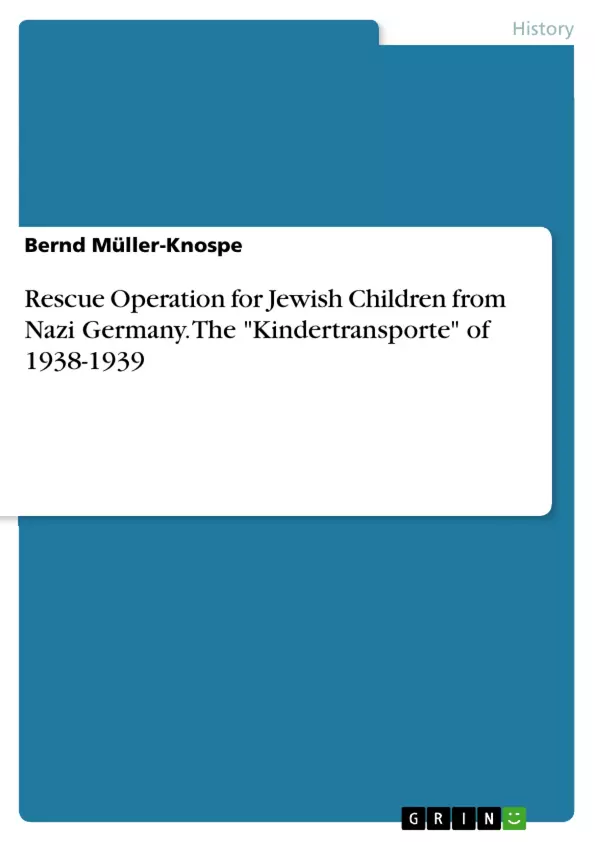This paper gives a brief overview about the rescue mission for over 10.000 Jewish children before the World War II started. In April 1933, only a few weeks after the victory of the Nazi party in the general election, a call for a general boycott of Jewish businesses was issued by the Nazis. Members of the SA distributed leaflets and painted yellow Stars of David and anti-Semitic slogans on shop windows: “Germans, defend yourselves, don’t buy from Jews!”. Anti-Jewish legislation with the aim of completely excluding Jews from the economic, social and cultural life in Germany would soon follow.
On November 9 in 1938, open violence broke out against the Jewish population in the German Reich. These pogroms which were euphemistically called “night of broken glass”, as if only a few shop windows of Jewish businesses had been broken. The Nazis wanted it to appear as an outbreak of spontaneous anger of German citizens about the murder of German diplomat Ernst vom Rath in Paris by Herschel Grynszpan, a young Jewish man on 7 November 1938 but in reality it had been meticulously prepared and organized by the Nazi administration and party organizations.
The pogroms lasted for two days, 250 synagogues were burned down as the fire brigades and police stood watching, thousands of Jewish businesses were destroyed, Jewish facilities like hospitals, schools and cemeteries were attacked and devastated, dozens of Jews were killed and thousands were humiliated and injured. After the pogroms thousands of Jewish men were arrested and sent to concentration camps, limitations on the free movement of the Jewish population became more and more severe. Jews were more or less barred from public life, children were expelled from public schools, a system of complete segregation of the entire Jewish population was introduced.
Inhaltsverzeichnis (Table of Contents)
- Pogroms of 1938 - The "Night of Broken Glass"
- Kindertransporte
- World War II
- After the war
- Sources
Zielsetzung und Themenschwerpunkte (Objectives and Key Themes)
This work explores the events surrounding the Kindertransporte, a rescue operation that brought thousands of Jewish children from Nazi Germany and occupied territories to safety in Britain during the years 1938-1939. The text delves into the historical context of the pogroms of 1938, analyzes the motivations behind the Kindertransporte, and examines the experiences of the children who participated in this daring rescue mission.
- The historical context of the pogroms of 1938 and the rise of Nazi Germany
- The motivations behind the Kindertransporte, including the role of British Jewish leaders, the British government, and individual citizens
- The experiences of the Jewish children who were rescued by the Kindertransporte, including their integration into British society and the challenges they faced
- The impact of World War II on the Kindertransporte children
Zusammenfassung der Kapitel (Chapter Summaries)
- Pogroms of 1938 - The "Night of Broken Glass": This chapter provides a detailed account of the Kristallnacht pogroms of November 9-10, 1938, highlighting the systematic violence and persecution unleashed against Jewish communities in Germany. It examines the Nazi government's role in instigating the pogroms and the devastating consequences for Jewish individuals and institutions.
- Kindertransporte: This chapter focuses on the origins and implementation of the Kindertransporte, exploring the efforts of British Jewish leaders to secure safe passage for Jewish children from Germany and Austria. It delves into the British government's response, the organization and logistics of the transports, and the experiences of the children upon arrival in Britain.
Schlüsselwörter (Keywords)
The primary keywords and focus topics of this work include Kindertransporte, Kristallnacht, Jewish persecution, Nazi Germany, British rescue mission, refugee children, integration, and World War II.
- Arbeit zitieren
- Bernd Müller-Knospe (Autor:in), 2017, Rescue Operation for Jewish Children from Nazi Germany. The "Kindertransporte" of 1938-1939, München, GRIN Verlag, https://www.grin.com/document/379374



